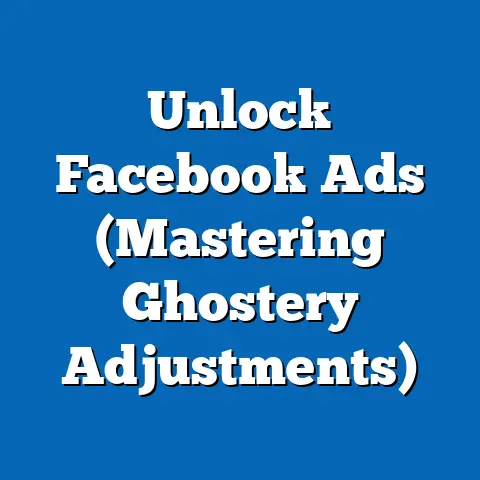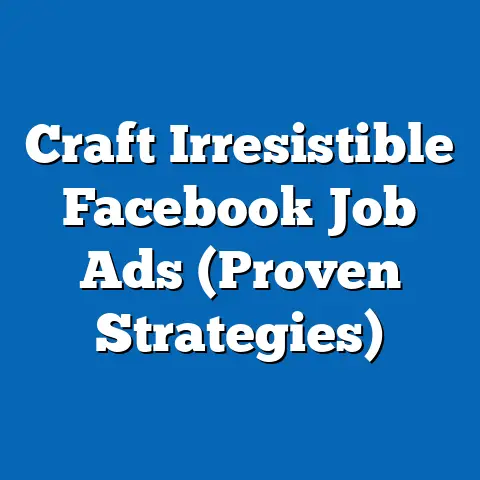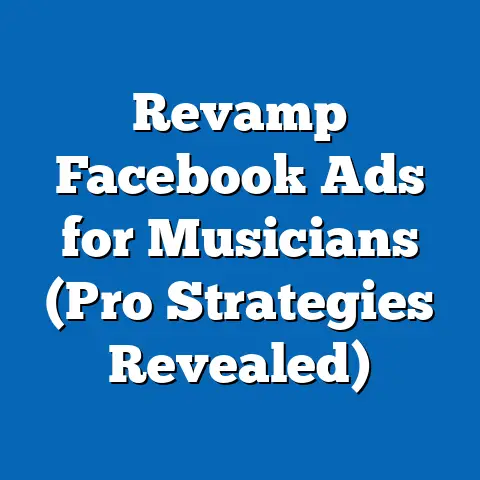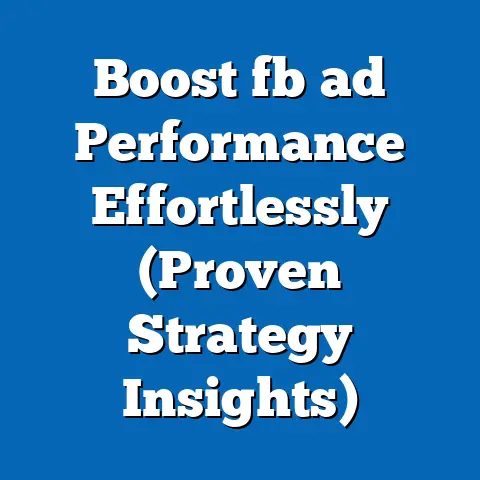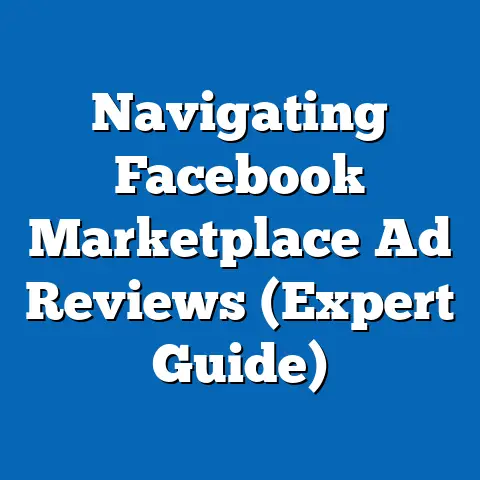Unlock Facebook Ad Success (Proven Analysis Techniques)
Facebook advertising can feel like throwing spaghetti at the wall – you create an ad, launch it, and hope something sticks. But, in my experience, that’s a recipe for wasted budget and frustration. The real magic, the secret sauce to Facebook ad success, lies not just in crafting beautiful ads, but in meticulously analyzing their performance. I’ve seen firsthand how businesses that embrace data-driven decision-making consistently outperform those who rely on gut feelings.
Think of it this way: Facebook Ads Manager is a treasure trove of information, but it’s up to you to be the archaeologist, carefully excavating the insights that will lead you to buried gold – increased ROI, laser-focused audience targeting, and a marketing strategy that actually works. Did you know that businesses that actively analyze their Facebook ad campaigns see an average of 30% higher ROI compared to those that don’t? That’s the power of understanding your data! Let’s dive into the proven analysis techniques that can unlock your Facebook ad success.
Understanding Facebook Ads Analytics
Navigating the Facebook Ads Manager can feel like deciphering a foreign language at first. It’s filled with acronyms and numbers, but each metric tells a story about your ad’s performance and how your audience is responding. Let’s break down some key players:
- Click-Through Rate (CTR): This is the percentage of people who saw your ad and clicked on it. A high CTR indicates that your ad is relevant and engaging to your target audience.
- Cost Per Click (CPC): This is the amount you pay each time someone clicks on your ad. A lower CPC means you’re getting more bang for your buck.
- Return on Ad Spend (ROAS): This is the holy grail! It measures the revenue you generate for every dollar you spend on ads. A ROAS of 3x means you’re making $3 for every $1 spent.
- Impressions: This is the number of times your ad was displayed, regardless of whether someone clicked on it.
- Reach: This is the number of unique people who saw your ad. Reach is important for brand awareness campaigns.
These metrics aren’t just random numbers; they’re vital signs of your ad campaign. By monitoring them, you can understand how your audience is interacting with your ads and make informed decisions to improve performance.
The Facebook Ads algorithm is another crucial piece of the puzzle. It’s a complex system that determines which ads are shown to which users, based on factors like relevance, bid amount, and estimated action rates. Understanding how the algorithm works can help you optimize your ads for better distribution and ultimately, more success. I’ve learned that consistently testing different ad variations and monitoring performance helps me understand how the algorithm responds to my campaigns, allowing me to fine-tune my strategy for maximum impact.
Hidden Benefits of Analyzing Facebook Ads
Beyond the obvious benefits of improving ROI and optimizing ad spend, analyzing your Facebook ads unlocks a treasure trove of hidden advantages. I’ve often found these unexpected insights to be even more valuable than the initial performance improvements.
One of the most significant hidden benefits is the ability to identify high-converting audience segments. By drilling down into your ad data, you can discover which demographics, interests, and behaviors are most likely to lead to conversions. For example, I once ran a campaign targeting a broad age range, but after analyzing the data, I realized that the 25-34 age group was converting at twice the rate of other segments. This allowed me to refine my targeting and focus my budget on the most profitable audience.
Analyzing ad performance also allows you to fine-tune your ad copy and creative elements. I’ve learned that even small changes can have a big impact on results. By testing different headlines, images, and calls-to-action, you can discover what resonates most with your target audience. I remember one instance where simply changing the color of the call-to-action button from blue to green resulted in a 20% increase in click-through rate. It’s these small, data-driven tweaks that can make all the difference.
Cost savings are another often-overlooked benefit of ad analysis. By identifying underperforming ads and audience segments, you can eliminate wasted ad spend and reallocate your budget to more effective strategies. I’ve seen campaigns where 50% of the budget was being spent on ads that generated little to no results. By cutting these ads and focusing on the winners, we were able to significantly improve overall campaign performance and reduce costs.
Proven Techniques for Analyzing Facebook Ads
Now, let’s get into the nitty-gritty of how to analyze your Facebook ads. Here are some proven techniques that I’ve used to achieve consistent success:
A/B Testing
A/B testing, also known as split testing, is the cornerstone of data-driven advertising. It involves creating two or more versions of an ad and running them simultaneously to see which performs better. The key is to test only one variable at a time to accurately measure its impact.
For example, you might test two different headlines:
- Ad A: “Get 20% Off Your First Order”
- Ad B: “Limited Time Offer: 20% Off”
By running these ads against the same audience, you can determine which headline generates a higher click-through rate or conversion rate.
I always recommend testing variables such as:
- Headlines: Test different value propositions, calls-to-action, and emotional appeals.
- Images/Videos: Experiment with different visuals to see what captures attention and resonates with your audience.
- Calls-to-Action: Try different CTAs like “Shop Now,” “Learn More,” or “Sign Up.”
- Ad Copy: Test different lengths, tones, and persuasive techniques.
- Audience Targeting: Experiment with different demographics, interests, and behaviors.
Remember to give your A/B tests enough time to gather statistically significant data. I typically run tests for at least a week, or until I have enough data to confidently declare a winner.
Audience Insights
Facebook Audience Insights is a powerful tool that provides detailed information about your target audience. It allows you to understand their demographics, interests, behaviors, and even their purchasing habits.
By leveraging Audience Insights, you can:
- Identify New Audience Segments: Discover hidden interests and behaviors that you might not have considered.
- Refine Your Targeting: Narrow down your audience to focus on the most relevant and responsive users.
- Create More Compelling Ad Copy: Craft ad copy that speaks directly to the interests and needs of your target audience.
- Understand Their Online Behavior: Learn what websites and apps your audience uses, what pages they like, and what content they engage with.
I often use Audience Insights to validate my assumptions about my target audience and to uncover new opportunities for growth. For example, I once discovered that my target audience was highly interested in a specific niche hobby that I hadn’t considered before. This led me to create a new ad campaign targeting that interest, which resulted in a significant increase in conversions.
Conversion Rate Optimization (CRO)
Conversion Rate Optimization (CRO) is the process of improving your website or landing page to increase the percentage of visitors who take a desired action, such as making a purchase, filling out a form, or signing up for a newsletter.
In the context of Facebook ads, CRO is crucial because it determines how effectively you convert ad clicks into paying customers. Even if you have a high click-through rate, your campaign will fail if your landing page doesn’t convert visitors into customers.
Here are some steps to analyze your landing pages for CRO:
- Analyze Your Website Analytics: Use tools like Google Analytics to track user behavior on your landing page. Look for drop-off points, bounce rates, and time on page.
- Conduct User Testing: Ask real users to navigate your landing page and provide feedback on their experience.
- Optimize Your Landing Page: Based on your analysis, make changes to your landing page to improve its usability, clarity, and persuasiveness.
- A/B Test Your Changes: Test different versions of your landing page to see which performs better.
I’ve found that focusing on CRO can significantly improve the ROI of my Facebook ad campaigns. By optimizing my landing pages, I’ve been able to increase conversion rates by as much as 50%, resulting in a dramatic increase in sales.
Using Pixel Data
The Facebook Pixel is a small piece of code that you place on your website to track user behavior after they click on your ad. It allows you to:
- Track Conversions: See which ads are driving the most conversions, such as purchases, leads, or sign-ups.
- Retarget Website Visitors: Show ads to people who have visited your website but haven’t yet converted.
- Create Lookalike Audiences: Find new customers who are similar to your existing customers.
- Optimize Your Ads: Use pixel data to optimize your ads for conversions.
Pixel data is essential for creating effective retargeting campaigns. Retargeting involves showing ads to people who have already interacted with your brand, such as visiting your website or adding items to their cart. These users are more likely to convert because they’re already familiar with your brand and your products.
I always recommend installing the Facebook Pixel on your website as soon as possible. The sooner you start collecting data, the sooner you can start optimizing your campaigns for better results.
Case Studies
Let’s look at a few real-world examples of how businesses have used analysis techniques to improve their Facebook ad campaigns:
Case Study 1: E-commerce Store
- Challenge: Low conversion rates on Facebook ads.
- Solution: Implemented A/B testing on ad headlines and images.
- Results: Increased conversion rates by 35% and reduced cost per acquisition by 20%.
- Key Takeaway: A/B testing is crucial for optimizing ad performance.
Case Study 2: Lead Generation Company
- Challenge: Difficulty targeting the right audience on Facebook.
- Solution: Used Facebook Audience Insights to identify new audience segments.
- Results: Increased lead generation by 40% and improved lead quality.
- Key Takeaway: Audience Insights can uncover hidden opportunities for growth.
Case Study 3: Local Restaurant
- Challenge: Low website traffic from Facebook ads.
- Solution: Optimized landing page for conversion rate optimization (CRO).
- Results: Increased website traffic by 50% and boosted online orders.
- Key Takeaway: CRO is essential for converting ad clicks into customers.
These case studies demonstrate the power of analysis techniques in improving Facebook ad performance. By embracing data-driven strategies, businesses can achieve significant results and unlock the full potential of their advertising efforts.
Common Pitfalls to Avoid in Facebook Ads Analysis
While analyzing your Facebook ads is crucial for success, it’s important to avoid common pitfalls that can lead to misleading conclusions and ineffective strategies.
One of the biggest mistakes is focusing on vanity metrics instead of actionable insights. Vanity metrics, such as likes, shares, and comments, may make you feel good, but they don’t necessarily translate into sales or leads. Instead, focus on metrics that directly impact your bottom line, such as conversion rates, cost per acquisition, and return on ad spend.
Another common mistake is jumping to conclusions based on limited data. It’s important to analyze data over time to see meaningful trends. Don’t make drastic changes to your campaigns based on a single day or week of data. Give your tests enough time to gather statistically significant results.
Finally, don’t be afraid to experiment and try new things. The Facebook advertising landscape is constantly evolving, so it’s important to stay up-to-date on the latest trends and best practices. Continuously test different strategies and analyze the results to see what works best for your business.
Conclusion
Unlocking success in Facebook advertising is not about luck or guesswork; it’s about embracing data-driven strategies and continuously refining your campaigns based on the insights gained through proven analysis techniques. By understanding key metrics, leveraging tools like Audience Insights and the Facebook Pixel, and avoiding common pitfalls, you can transform your Facebook ads from a cost center into a profit engine.
I encourage you to start applying these techniques in your own Facebook ad strategies today. Dive into your data, experiment with different approaches, and track your results. The more you analyze and optimize, the better your campaigns will perform. Unlock the hidden potential of your advertising efforts and watch your business grow! So, what are you waiting for? Go analyze your ads and start seeing the results you deserve!

